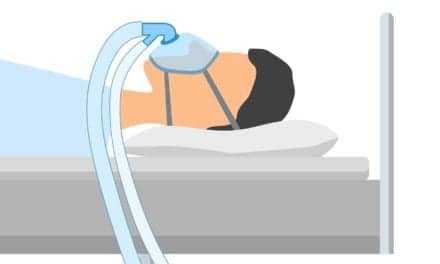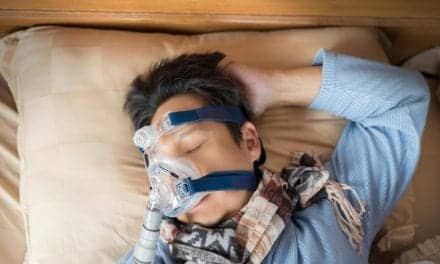Two patients suffering from migraine and OSA were successfully treated with nasal CPAP.
By Lawrence T. Chien, MD, FAAP, FAAN, ABSM
Current therapies for patients with migraine headaches include avoiding triggers such as ingestion of cheese and chocolate, and avoiding allergic factors. Stress and not eating may also bring on migraine attacks. Hormonal factors during a woman’s menstrual cycle certainly may affect migraine occurrence as well. Sleep hygiene has been proven to help children and adolescents to reduce mean duration and frequency of migraine attacks as reported by Bruni et al.1
Patients with cluster headaches seen in the emergency department are often treated with low flow oxygen. In patients with OSA and migraine headaches, there is associated hypoxia and hypercarbia. Hypercarbia has been known to be a strong cerebral vascular dilator and worsen any headaches by increasing brain volume. This article reports on two patients with remarkable improvement of migraine frequency and severity after nasal CPAP treatment was administered for their sleep apnea.
Case One
A 37-year-old man was first seen in the neurology office due to excessive daytime sleepiness and severe headaches. The patient said he had worked in the restaurant business with a schedule of Monday through Saturday from 7:30 to 8:00 am until around 10:00 am. After 1 hour of rest, he then went back to work at 11:00 am until 10:00 pm. At night, it took him some time to unwind and fall asleep, usually around 11:00 to 11:30 pm.
He was able to sleep through the night and usually woke up between 6:30 and 7:00 am to go to work. He said that if he got up at night, he would eat cookies, drink milk, and go back to sleep without any problem.
He used to snore, but his wife said that his snoring had improved after losing nine pounds. On Sundays, he fell asleep while in church; however, as long as he was active, he could stay awake.
In the past, he had never experienced head injuries or been in motor vehicle accidents; he occasionally smoked a cigar. He was allergic to Tylenol and complained that his headaches were in the vertex area, radiating down his neck. The headaches were described as pounding and severe. He would have bitemporal headaches without vomiting; however, he could not eat during the headaches due to “sickness in the stomach.” Sometimes his headaches lasted for 3 1/2 days and affected his sleep.
Family history was strongly positive for migraine headaches including his own sister; therefore, he would borrow her medication to treat his own headaches. His sister was prescribed a butalbital combination drug (Fiorinal #3), which he said worked very well for him. Aspirin, acetaminophen, and caffeine powders failed to relieve his headaches, and complete physical, mental, and neurological examinations were unrevealing. The patient was not obese, weighing 177 pounds. He was six feet tall and blood pressure was 114/82 mm Hg. The patient was diagnosed to have probable migraine headaches with additional musculoskeletal tension headaches. He was also considered to have a sleep disorder. His excessive daytime sleepiness could have been due to a circadian sleep disorder due to the busy restaurant business. Sleep apnea, anxiety, and depression were also considered.
The patient was given 25 mg of amitriptyline at bedtime, which was started for both migraine prevention and improving his sleep. One dose of 25 mg of Fiorinal #3 and promethazine was prescribed daily if necessary for acute migraine attacks. The patient was treated periodically with additional medication, and he made many phone calls to the sleep center requesting refills. Fiorinal #3 along with sumatriptan for acute attacks and occasionally butorphanol tartrate nasal spray were given for 9 years. The patient was followed in the clinic every 2 to 3 months. He was tried on 120 mg of propranolol (long acting) every morning, but it was not effective and therefore was discontinued. Amitryptyline was discontinued due to drowsiness, which carried over to the next morning. The patient had been giving himself injections of 6 mg of sumatriptan subcutaneously for acute attacks. Over the years, he had headaches at least twice a week, some lasting up to 2 days. For 2 years, the patient had severe headaches relieved only by butorphanol tartrate nasal spray. He was later followed in the office every 4 months. The patient was also treated with 5 mg of zolmitriptan four times a month during acute attacks, and 10 mg of rizatriptan benzoate was also given as an alternative. The patient complained that he did not sleep well and had occasional snoring after 7 years of treatment. The patient also felt sleepy while driving and tired throughout the day. He felt unrefreshed in the mornings after he woke up, and the headaches were associated with photophonophobia, nausea, and vomiting. He thought the headaches were due to working 16 to 18 hours per day, since his business had been improving. He was given budesonide samples to open his nasal passages; however, his headaches were getting worse. After 9 years of treatment, a polysomnogram followed by nasal CPAP was ordered. The polysomnogram was performed when he was 46 years old in an accredited sleep laboratory due to progressive loud snoring, daytime tiredness, and sleepiness. After the test, the patient felt well. The total recording time was 432 minutes, with a total sleep time of 382.5 minutes, and a sleep efficiency measure of 72.2%. Sleep onset was delayed to 20 minutes, and REM onset was at 67 minutes; four REM periods were obtained. The patient spent 10.2% of the time awake in bed. Stage I was at 16.5%, stage II was at 51.4%, and REM sleep was at 21.6%. There was a total curtailment of stages III-IV sleep. The patient did have excessive waking in stage I, which therefore resulted in poor sleep efficiency.
Respiratory measurements showed a total of 113 apnea/hypopneas with an apnea/hypopnea index of 17.7/h. Total arousals were 113 and the patient’s arousal index was 17.7/h. Obstructive and mixed apneas numbered 22, and hypopneas were 92. During REM sleep, the apnea/hypopnea index was 30.5/h. The lowest Spo2 was 83%, and the longest respiratory event was 33 seconds of obstructive hypopnea with an Spo2 of 94%.
Excessively loud snoring was present, especially when the patient was sleeping on his left or right side and in the supine position. ECG was normal while he was asleep, and his respiratory rate while sleeping was 17 to 19 per minute; while awake, it was 16 per minute.
On the following day, a polysomnogram with nasal CPAP titration was conducted. After nasal CPAP was administered, the patient estimated a sleep latency of 5 minutes. The total sleep time was 7 hours. He did not recall any dreams, but he remembered one nocturnal awakening. He had no problem falling back to sleep. His sleep was more refreshing while treated with nasal CPAP. He was ready to go back to work and his sleep was quite restful.
The total recording time was 384 minutes and total sleep time was 326.5 minutes. The sleep efficiency measure was 73.8%. Sleep onset occurred in 9.5 minutes, and REM onset at 64 minutes; there were three REM periods recorded.
The patient was titrated with a pressure of up to 13 cm H2O using a large CPAP mask. He spent 13.9% of the time awake in bed. Stage I sleep occupied 11.3%, stage II was at 55.7%, stages III/IV were at 5.1%, and REM sleep was at 13.9%. Stages III/IV sleep appeared on the second night. His respiratory measurements showed that apnea/hypopnea and oxygen desaturation were abolished by the nasal CPAP at a pressure of 13 cm H2O; however, in supine position mild intermittent snoring was still heard. ECG and respiratory rates also did not change. Subjectively, the patient felt better while on nasal CPAP; therefore, he went home with the nasal CPAP at the above setting as well as a cool mist humidifier. After he was treated with nasal CPAP, the patient’s headaches became infrequent. He had two headaches in 6 months and gradually was able to be drug free. His daytime sleepiness was eliminated as well.
Case Two
A 59-year-old man was evaluated due to chronic headaches, loud snoring at night, and witnessed sleep apnea. The patient stated that for many years he had been having severe headaches and had many allergies. At night, his nasal airflow was obstructed. When tears came out of his eyes, the tear ducts appeared to be blocked. He had been awakened by severe headaches at night and had to use sumatriptan injections and zolmitriptan for migraine attacks. During the day, he was tired and sleepy. His wife had to move to a separate room due to his loud snoring, while at the same time worrying about his sleep apnea. The patient did not drink alcohol or smoke cigarettes, yet stated that he did drink coffee, tea, or caffeinated soft drinks to stay alert. His normal bedtime was 11:00 pm to 12:00 am at night. His normal wake time was 7:00 to 7:30 am.
The patient did have oral and nasal surgery in the past. Regular medications included propoxyphene and acetaminophen, tamsulosin, and triprolidine and pseudoephedrine.
The patient usually got approximately 6 to 7 hours of sleep per night. On the weekends, he went to bed 1 hour later. It did not take him long to fall asleep, and he typically woke up three to four times at night—each time for approximately 5 to 10 minutes. As soon as he was awake in the morning, he got out of bed. After an average night of sleep, he still usually felt drowsy and was tired for 1 hour. By the afternoon, he would feel better.
On examination, the patient appeared to be overweight at 267 pounds and was 6 feet 1 inch tall. His blood pressure was 150/90, and because of OSA symptoms, an overnight polysomnography and nasal CPAP titration were carried out.
The morning following the nocturnal polysomnogram, the patient stated that it took him 2 hours to fall asleep and that he had a headache. He slept for an estimated time of 4 hours. He did not recall any dreams or waking up during the night.
The total recording time was 402.2 minutes, and the total sleep time 319.7 minutes. Sleep latency was 32 minutes, and REM latency was 130.5 minutes. The patient had a sleep efficiency measure of 76.1%, and three REM periods were obtained. The patient spent 13.6% of his time awake in bed. Stage I was at 10.3%, stage II: 57.9%, stages III and IV: 7.3%, and REM sleep: 10.9%. The patient had extremely loud snoring.
Respiratory measurements showed a total of 418 apneas and hypopneas, a respiratory index of 78.5/h, a REM respiratory distress index (RDI) of 69.6/h, and a non-REM RDI of 79.7/h. Total arousals were 416 and the arousal index was 78.1/h. He had 85 obstructive and mixed apneas, zero central apneas, and 333 hypopneas.
The lowest oxygen nadir was 78%. The longest event was an 80.9-second non-REM obstructive hypopnea with an Spo2 of 92%. The longest event during REM was a 37.7 apnea with an Spo2 of 89%. There were a total of 23 periodic limb movements (PLMs) during sleep, and the PLM index was 4.3/h, but they were not associated with arousals. The ECG showed no abnormalities.
The patient had severe apnea syndrome associated with arousals, oxygen desaturation, and disruption of sleep architecture; therefore, nasal CPAP titration was performed. The following morning after nasal CPAP treatment was given, the patient stated that it took him an estimated 20 to 30 minutes to fall to sleep. He slept for 6 to 7 hours but did not recall any dreams. He woke up once but had no problem falling back asleep. He stated that his sleep was a lot more refreshing than what he experienced at home. He actually felt good in the morning.
Electrophysiological measurements showed that he had a total recording time of 419 minutes and a total sleep time of 324.4 minutes. His sleep efficiency measure was at 68.5% and sleep latency was 24.2 minutes. The REM latency was 97 minutes and two REM periods were obtained. The patient spent 17.9% of sleep time awake in bed. Stage I was at 17.9%, stage II: 44.7%, stages III and IV: 4.7%, and REM sleep: 19.1%. The patient had excessive waking; however, he did have a deep sleep and REM sleep was well represented.
Respiratory measurements showed two total apneas and hypopneas, an apnea/hypopnea index 1/h, two total arousals, and an arousal index of 1/h. The patient’s snoring was completely eliminated with nasal CPAP set at 16 cm H2O pressure and all apneas/ hypopneas were eliminated. The patient did have 206 PLMs during sleep and a PLM index of 38.1/h. While on nasal CPAP, he had 17 PLMs with arousals and the PLM arousal index was 3.1/h. ECG again was negative for abnormalities.
The patient showed excessive waking and stage I. There was increased sleep latency, decreased stage II, and REM sleep. Respiratory parameters showed improvement with an elimination of sleep-disordered breathing. The PLMs in sleep did not cause him to arouse, but there might have been some sleep stage changes. The patient was advised to use 16 cm H2O nasal CPAP pressure with a large full-face mask. A cool mist humidifier and chinstrap were also prescribed.
After nasal CPAP treatment, the patient’s headaches improved dramatically. The migraine attacks became infrequent and snoring was also eliminated with an improvement of daytime alertness and energy. The patient almost became drug free for the treatment of his headaches.
Discussion
We have presented two patients with migraine headaches and OSA. They both had dramatic improvement of the headaches after nasal CPAP was used for treatment of OSA. Bruni and coworkers1 have presented evidence that in children and adolescents improvement of sleep hygiene reduced mean duration and frequency of migraine attacks. Hypercarbia is a strong cerebral vascular dilator. The dilatation of the vascular system in the brain certainly may increase brain volume and potentially may cause headaches. Sleep deprivation may also precipitate migraine. Most patients with sleep apnea may also have triggers of migraines such as anxiety and stress. The improvement of ventilation and sleep architecture by nasal CPAP may have a positive impact on sleep quality, thereby improving migraine control.
Patients in the sleep center are usually instructed to pay attention to sleep hygiene, reduce the consumption of alcohol and cigarette smoking, and lose weight. These measures may also help migraineurs to reduce their attacks.
Idiman et al2 showed no statistically significant relationship between headaches and the apnea/hypopnea index or minimum oxygen desaturation. This is not surprising since migraines can be triggered by so many factors. Proper sleep hygiene is important to help prevent and avoid sleep deprivation and migraines. Mean duration and frequency of migraine attacks were significantly reduced when proper sleep hygiene was maintained. Improvement of sleep architecture by nasal CPAP certainly would have the same beneficial effect as sleep hygiene.
Cluster headaches are one type of migraine attack that occurs most often in men. They are characterized by severe, one-sided, periorbital pain in the temporal area. They come with lacrimation, rhinorrhea, forehead perspiration, and flushing of the cheek area. Onset and termination of the pain are usually abrupt, with the usual duration lasting no more than 2 hours. Low-flow oxygen has been a common treatment in the emergency department for cluster headaches, and improvement of oxygenation by nasal CPAP may have the same positive effect to reduce other types of migraines. The dramatic improvement of migraine control in our sleep apnea patients was commonly observed, which prompted us to report on these two cases.
Lawrence T. Chien, MD, FAAP, FAAN, ABSM, is clinical associate professor, University of Tennessee, Medical Unit, and Memorial Regional Sleep Center, Chattanooga; and Anne P.Y. Chien, MSN, APN, NP-C, is clinical associate professor, University of Tennessee School of Nursing, Chattanooga.
References
1. Bruni O, Galli F, Guidetti V. Sleep hygiene and migraine in children and adolescents. Cephalalgia. 1999;19(suppl 25):57-59.
2. Idiman F, Oztura I, Baklan B, et al. Headaches in sleep apnea syndrome. Headache. 2004;44:603-606.





